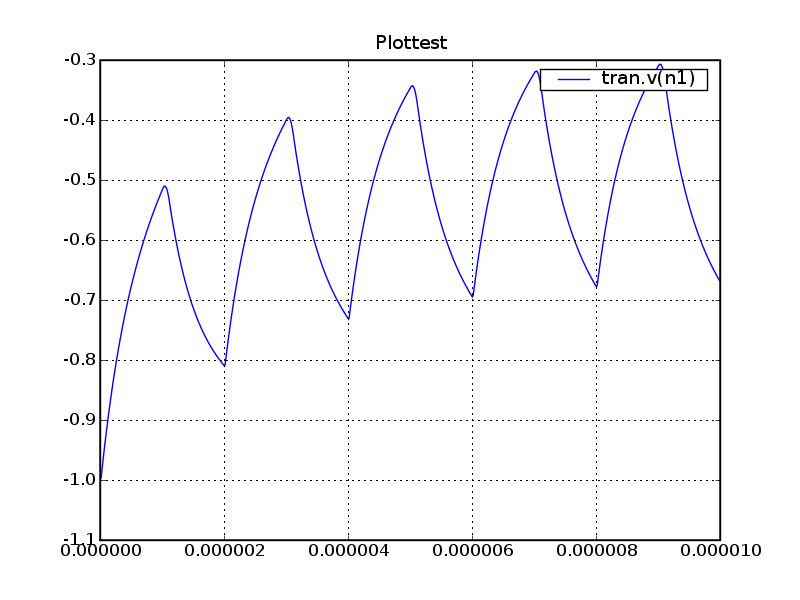
werner@werner-amd64:~/oss/python_spice/test> ../src/spice_read.py complicated_binary.raw
The file: "complicated_binary.raw" contains the following plots:
Plot 0 with the attributes
Title: * simulation de RC2
Date: Mon Sep 3 19:53:05 2007
Plotname: AC Analysis
Plottype: plottype undefined
The Scale vector has the following properties:
Name: frequency
Type: frequency
Vector-Length: 201
Vector-Type: float64
Data vector 0 has the following properties:
Name: ac.v(n2)
Type: voltage
Vector-Length: 201
Vector-Type: complex128
Data vector 1 has the following properties:
Name: ac.v(n1)
Type: voltage
Vector-Length: 201
Vector-Type: complex128
Data vector 2 has the following properties:
Name: ac.v(n2)
Type: voltage
Vector-Length: 201
Vector-Type: complex128
Plot 1 with the attributes
Title: * simulation de RC2
Date: Mon Sep 3 19:53:05 2007
Plotname: DC transfer characteristic
Plottype: plottype undefined
The Scale vector has the following properties:
Name: v-sweep
Type: voltage
Vector-Length: 501
Vector-Type: float64
Data vector 0 has the following properties:
Name: dc.v(n1)
Type: voltage
Vector-Length: 501
Vector-Type: float64
Data vector 1 has the following properties:
Name: dc.v(n2)
Type: voltage
Vector-Length: 501
Vector-Type: float64
Plot 2 with the attributes
Title: * simulation de RC2
Date: Mon Sep 3 19:53:05 2007
Plotname: Transient Analysis
Plottype: plottype undefined
The Scale vector has the following properties:
Name: time
Type: time
Vector-Length: 1069
Vector-Type: float64
Data vector 0 has the following properties:
Name: tran.v(n1)
Type: voltage
Vector-Length: 1069
Vector-Type: float64
|
#!/usr/bin/python from pylab import * sys.path.append("../src/") import spice_read plotlist = spice_read.spice_read("../test/complicated_binary.raw").get_plots() plot2 = plotlist[2] x = plot2.get_scalevector().get_data() for v in plot2.get_datavectors(): plot(x, v.get_data(), label=v.name) title("Plottest") grid() legend() savefig("short_test.png") close() |
The script results in a simple plot written into a bitmap file:

The script spice2hdf5 reads spice files and writes them into a hdf5 file. The script can create tables of each simulation or store each vector of the simulation as an array. The command line interface offers some options to store the spice plots at different places in the hdf5 file.
werner@linux-m82i:~/oss/python_spice/src> ./spice2hdf5.py -h
spice2hdf5 version 0.0.2 (C) Werner Hoch
usage: ./spice2hdf5.py [options], spicefile, [spicefile2, ..]
-h --help: print help information
-v --verbose: print debug messages to stdout
-o --outfile: specify the hdf5 output filename (default: out.hdf5)
-p --pathprefix: location to store the spice data
-f --format: whether to store the data as single vectors or table
(default: table)
|
You can now store data in a hdf5 file
> spice2hdf5.py --pathprefix=/vectors -f vectors *raw > spice2hdf5.py --pathprefix=/tables -f table -o out.hdf5 *raw > spice2hdf5.py --pathprefix=/ac/myname ac_binary.raw > spice2hdf5.py -f vectors -o out.hdf5 dc_binary.raw |
You can use the program ViTables to view the data stored in the hdf5 file and read it using the python tables module. Here is a screenshot from ViTables with some spice data:

programming language: python
natural language: english
licence: the DE-solver has a BSD-like licence, please read the
head of the src/diffev.py file. The spice import filter
src/spice_read.py and the conversion utility src/spice2hdf5.py uses
GPL2 all other files and examples are released into public domain.
download: python_spice-0.0.3.tar.gz